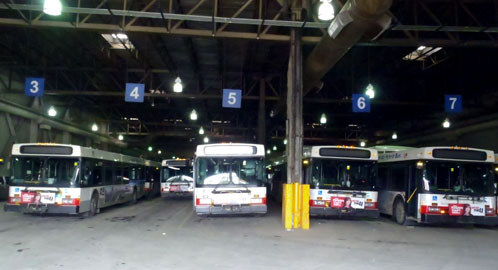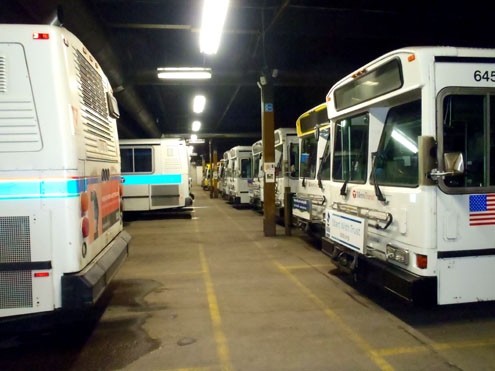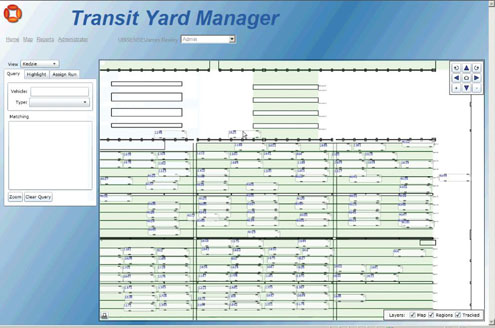
Real time locating systems save transit agencies time
By Adrian Jennings
It is difficult in today’s technology-driven society to imagine large transit operators relying on pen and paper to manually track the location of the buses in their fleet. Nonetheless, for many transit organizations this is still the reality. More transit agencies such as Metro Transit, Minneapolis, MN, are replacing this outdated, error-prone process with advanced real time locating technologies that provide greater visibility for transit yard management, and at the same time realize positive savings in time and costs.
Real-time location systems (RTLS) involve a network of tags and sensors that operate automatically in real time to locate specific physical assets such as transit buses. Metro Transit, which tracks approximately 900 buses, replaced its manual markup sheets with electronic versions that incorporate RTLS, making it easier and faster to locate dispatched and parked buses. It even helps in making maintenance and repair assessments.


Find the buses
RTLS provides significant return on investment (ROI) by simply helping a driver, mechanic custodian or an outside contractor locate a bus in a parking facility that needs immediate attention. For example, a contractor may need to access all buses with video monitoring systems. With RTLS installed in the garage the contractor uses a computer to query the database for the location of all vehicles using that particular type of video surveillance equipment. A printable map showing the location of all such buses is instantly generated, allowing the contractor to complete his work more efficiently. Since most maintenance contracts are invoiced on a time-on-site basis, removing bus-locating delays can translate into real cost savings.
 The maintenance staff can leverage similar efficiencies when it is time to locate particular vehicles due for repair. Location systems can annotate a map view of the parking garage with icons depicting bus status. With one click of the mouse a technician can locate all the buses scheduled for routine maintenance.
The maintenance staff can leverage similar efficiencies when it is time to locate particular vehicles due for repair. Location systems can annotate a map view of the parking garage with icons depicting bus status. With one click of the mouse a technician can locate all the buses scheduled for routine maintenance.
Park the buses
In addition to locating buses faster, RTLS can help transit operators park buses in a more strategic manner to prevent blockage and departure delays. A bus arriving at the parking garage may have developed a critical fault detected by the on board monitoring equipment. Without RTLS the maintenance staff may query the system only to find the bus boxed in by several buses that need to be shuffled in order to retrieve the vehicle.
With RTLS giving the location and status of all buses in the garage, drivers can be instructed to park their buses more precisely to prevent blockage, of move those in need of service into holding area, allowing the maintenance staff to retrieve a particular faster.
In a garage equipped with RTLS the system can alert the maintenance staff when a vehicle with a critical fault enters the facility direct it to the best location before others block its removal. Again, such real time reductions in frustrating delays translate into real savings.
Dispatch the bus
Nothing causes greater frustration to transit operators than delayed departures. On-time pullouts are critical in maintaining a set schedule and quality customer service. A computer-aided dispatch (CAD) system ensures the correct buses are traveling the correct routes at the correct time.
However, in an indoor parking structure where buses are typically parked in long rows, one mistake in locating a bus can delay its pulling out on time. RTLS is capable of coordinating the pull out sequence of buses parked in designated spaces.
Even with solid bus location data the unexpected can still occur. One flat tire or non-starting bus can block other buses and hinder their pullouts. Such incidents require contingency plans that can be implemented immediately to the affected vehicles on schedule. This may involve significant shuffling and assigning buses to other routes, and is only made easier with the information RTLS can offer about the exact location of all the vehicles in the garage.
RTLS gives transit operators the exact location information they need. It virtually peels the roof off to provide a real time overview unachievable with a manual process. It allows the chance to identify and rectify issues by implementing more efficient shop routines that reduce downtime due to the movement of vehicles.
Let’s say in an operation running both single and articulated buses the articulated buses always leave the oil change station later than planned, which creates issues in getting them back into service. Even though the maintenance staff reports the oil changes are being completed within the allotted time, no one can explain the reason for the delays. RTLS can shed some light.
A timeline graphic showing the usage of a particular oil change station points immediately to a probable cause. While the articulated buses are serviced within the allotted time, they are always last in line. Meanwhile, service on a particular class of single buses is taking longer than expected.
The articulated buses are not late because of an issue with them, but because their service begins later due to issues with other vehicles. The root cause is with the single buses.
RTLS can quickly detect when a bus has remained in the maintenance bay longer than expected or has not arrived at the expected time. This data requires no manual intervention since location updates are automatic. Messages and alerts can be sent via e-mail, text message or digital display on the most current location of all vehicles to expedite scheduling adjustments and avoid costly delays. BR
Adrian Jennings serves as vice president of technology for Ubisense Inc., a leading provider of location solutions.

